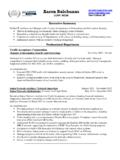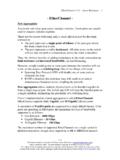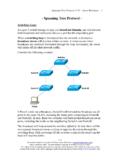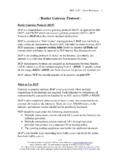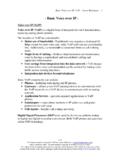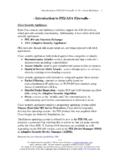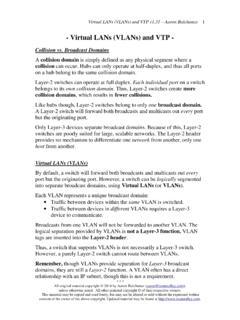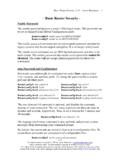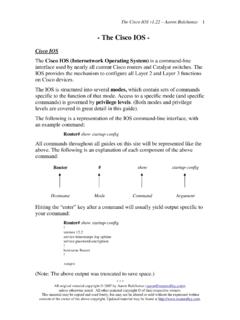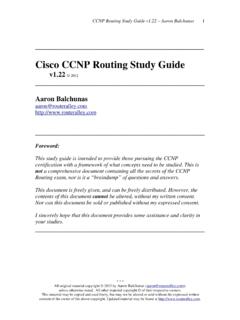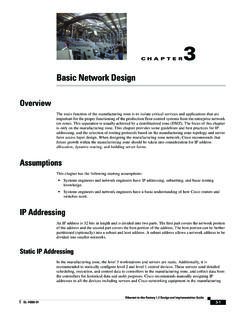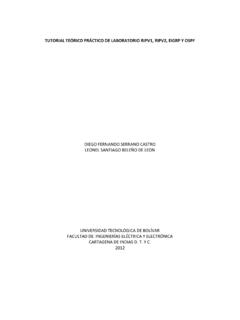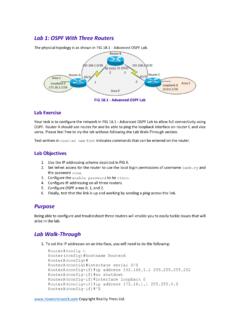Transcription of Multiprotocol Label Switching
1 MPLS Aaron Balchunas * * * All original material copyright 2007 by Aaron Balchunas unless otherwise noted. All other material copyright of their respective owners. This material may be copied and used freely, but may not be altered or sold without the expressed written consent of the owner of the above copyright. Updated material may be found at 1 - Multiprotocol Label Switching - Multiprotocol Label Switching Multiprotocol Label Switching (MPLS) is a Layer-2 Switching technology. MPLS-enabled routers apply numerical labels to packets, and can make forwarding decisions based on these labels. The MPLS architecture is detailed in RFC 3031. MPLS reduces CPU-usage on routers, by allowing routers to make forwarding decisions solely on the attached Label , as opposed to parsing the full routing table.
2 Labels can based on a variety of parameters: Destination IP network Source IP address QoS parameters VPN destination Outgoing interface Layer-2 circuit MPLS is not restricted to IP, or any specific Layer-2 technology, and thus is essentially protocol-independent. Labels are applied to and removed from packets on edge Label Switch Routers (edge LSRs). Only edge routers perform a route-table lookup on packets. All core routers (identified simply as LSRs) in the MPLS network forward solely based on the Label . As a packet traverses the core MPLS network, core routers will swap the Label on hop-by-hop basis. MPLS is completely dependent on Cisco Express Forwarding (CEF) to determine the next hop.
3 (Reference: ; ) MPLS Aaron Balchunas * * * All original material copyright 2007 by Aaron Balchunas unless otherwise noted. All other material copyright of their respective owners. This material may be copied and used freely, but may not be altered or sold without the expressed written consent of the owner of the above copyright. Updated material may be found at 2 Cisco Express Forwarding (CEF) Multilayer switches contain both a Switching and routing engine. A packet must first be routed, allowing the Switching engine to cache the IP traffic flow. After this cache is created, subsequent packets destined for that flow can be switched as opposed to routed, reducing latency. This concept is often referred to as route once, switch many.
4 Cisco refers to this type of Multilayer Switching as NetFlow Switching or route cache Switching . As is their habit, Cisco replaced NetFlow multilayer Switching with a more advanced method called Cisco Express Forwarding (CEF). CEF is enabled by default on all Catalyst multi-layer switches (at least, those that support CEF). CEF cannot even be disabled on the Catalyst 3550, 4500 and 6500. CEF contains two basic components: Layer 3 Engine Builds the routing table and then routes data Layer 3 Forwarding Engine Switches data based on the FIB. The Layer 3 Engine builds its routing table using either static routes, or routes dynamically learned through a routing protocol (such as RIP or OSPF). The routing table is then reorganized into a more efficient table called the Forward Information Base (FIB).
5 The most specific routes are placed at the top of the FIB. The Layer 3 Forwarding Engine utilizes the FIB to then switch data in hardware, as opposed to routing it through the Layer 3 Engine s routing table. The FIB contains the following information: Destination networks Destination masks Next-hop addresses The MAC addresses of each next hop (called the Adjacency Table) To view the CEF FIB table: Switch# show ip cef MPLS Aaron Balchunas * * * All original material copyright 2007 by Aaron Balchunas unless otherwise noted. All other material copyright of their respective owners. This material may be copied and used freely, but may not be altered or sold without the expressed written consent of the owner of the above copyright.
6 Updated material may be found at 3 The MPLS Label Two forms of MPLS exist: Frame Mode MPLS utilizes a 32-bit Label that is injected between the Layer-2 and Layer-3 headers. Cell Mode MPLS used with ATM, and utilizes the VPI/VCI fields ATM header as the Label . This guide will concentrate on Frame Mode MPLS. The 32-bit Label has the following format: Label Experimental Bottom-of-Stack TTL 20 bits 3 bits 1 bit 8 bits Label (20 bits) Experimental (3 bits) This field is officially undefined, but is used by Cisco as an IP precedence value. Bottom-of-Stack (1 bit) This field indicates the last Label , as multiple labels are supported in the same packet. A value of 1 identifies the last Label in the stack.
7 TTL (8 bits) This field indicates the number of router this Label can live through. An Ethernet header is modified to indicate the presence of an MPLS Label . 0x8847 indicates a labeled unicast IP packet 0x8848 indicates a labeled multicast IP packet (Reference: ; ) MPLS Aaron Balchunas * * * All original material copyright 2007 by Aaron Balchunas unless otherwise noted. All other material copyright of their respective owners. This material may be copied and used freely, but may not be altered or sold without the expressed written consent of the owner of the above copyright. Updated material may be found at 4 The MPLS Components MPLS router designations include: LSR ( Label Switch Router) responsible for forwarding packets through the provider core based on the packet s Label .
8 Cisco refers to this as a P (provider) router. Edge LSR ( Label Edge Router) responsible for adding or removing labels from packets. Cisco refers to this as a PE (provider edge) router. Non- Label Routers Cisco refers to this as C (customer) routers LSRs perform the following functions: Control Plane - exchanges routing and Label information Data Plane - forwards actual packets based on Label information The Control Plane, in charge of information exchange, builds and maintains the following tables: routing Table routing information is exchanged between LSRs using a routing protocol, such as IGRP, eigrp , IS-IS, OSPF, or BGP. Label Information Base (LIB) Label information is exchanged between LSRs using a Label protocol, such as LDP ( Label Distribution Protocol) or TDP (Tag Distribution Protocol) LDP is now default on Cisco devices, and uses TCP port 646.
9 TDP is a Cisco-proprietary Label protocol, and uses TCP port 711. Label convergence will occur after routing convergence is completed. Label protocols require the underlying routing infrastructure in order to function. The Data Plane, in charge of information forwarding, maintains the following tables: The CEF Forwarding Information Base (FIB) for forwarding unlabeled packets. Contains destination IP networks, and the Layer-2 address of the next-hop router. Label Forwarding Information Base (LFIB) for forwarding labeled packets. MPLS Aaron Balchunas * * * All original material copyright 2007 by Aaron Balchunas unless otherwise noted. All other material copyright of their respective owners.
10 This material may be copied and used freely, but may not be altered or sold without the expressed written consent of the owner of the above copyright. Updated material may be found at 5 The MPLS Process There are four scenarios detailing how LSRs forward packets: 1. An unlabeled IP packet is received, and is routed unlabeled to the next hop. 2. An unlabeled IP packet is received, a Label is inserted in the header, and is switched to the next hop. 3. A labeled IP packet is received, the Label is swapped, and is switched to the next hop. 4. A labeled IP packet is received, the Label is stripped off, and is routed to the next hop or destination. Frame-mode MPLS performs as follows: 1. An edge LSR receives a packet.
